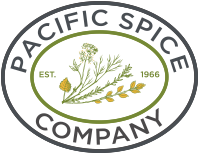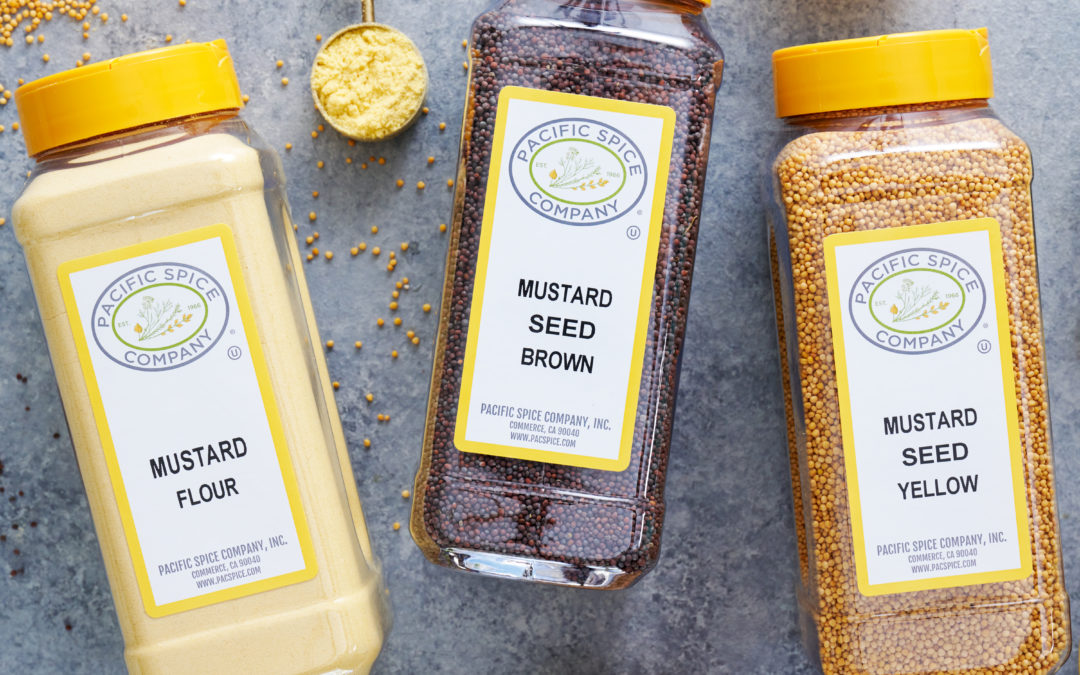“A tale without love is like beef without mustards: An insipid dish” – Anatole France
Mustard seed has a rich and fascinating history, as many ancient spices do. From its historical use in medicine, food, superstitious ceremonies, and even war, this tiny seed has had an extraordinary impact on the world.
In this blog, we’ll discuss the history, origins, and common uses for yellow, white, brown, and oriental mustard seed as well as mustard flour.
Flavor
The flavor of mustard is unmistakable – no other spice is quite like it. It’s best described as peppery, potent, and pungent. Depending on the type of seeds that are used, mustard can also have a prominent nasal clearing effect that is most similar to that of wasabi.
There are two main types of mustard seeds on the market today:
- Yellow and white mustard seeds have a sharp tongue taste that comes from a non volatile flavor substance.
- Brown and oriental mustard seeds have a higher level of fixed oil and volatile oil which produces a more pungent aroma and bite. These seeds produce a strong sinus-clearing sensation.
It might surprise you to learn that the seeds of the mustard plant must be broken and activated to release their flavor.
Mustard flour (also called ground mustard, or mustard powder) is not hot or potent when it’s dry. However, when it comes in contact with water, grape juice, or another comparable liquid, an enzyme called myrosinase is activated. This enzyme transforms mustard powder into a super potent condiment with a powerful impact. After it’s activated, the full flavor of mustard develops in about 10-15 minutes.
Many of us are familiar with mustard’s flavor due to the popularity of the mustard condiment, which is made mostly of dried and finely ground mustard seeds.
Here are a few additional fun facts about mustard:
- Heat and acid will impede its flavor and potency. Water is the best enzyme activator.
- Wine, vinegar, and lemon juice are poor flavor activators, yet great for flavor preservation.
- Low levels of mustard can activate your taste buds and enhance the flavors of other foods, unlike other spicy foods which can desensitize you.
- In cooking, mustard powder is best when activated with water and left to sit for 10-15 minutes before adding it to food.
Appearance
Mustard comes from the genus Brassica, the same genus that gives us cabbages and turnips. The two main types of mustard are Brassica hirta Moench, which produces yellow or white mustard seeds, and Brassica juncea L., which produces brown or oriental mustard seeds.
Each type of mustard plant has a slightly different appearance from the next; with flowers that are either yellow or white, and green leaves that range from lobed, to frilled, to smooth.
Yellow or White Mustard Seeds – Brassica hirta Moench
These seeds have a nearly round shape and grow to be about 3mm in diameter. They are a pale straw color, with the occasional light pink or tan seed.
Brown and Oriental Mustard Seeds – Brassica juncea L.
These seeds have a similar shape to yellow or white mustard seeds, yet are a bit smaller in size. Brown and oriental mustard seeds grow to be about 2mm in diameter. Brown seeds range in color from reddish brown to dark brown while oriental seeds are mostly yellow and occasionally light brown.
History

The long history of mustard seeds dates back to ancient times. The plant is believed to be native to Europe and Southeast Asia.
Mustard gets its name from “must”, which is unfermented grape juice. Early Romans liked to mix mustard seeds with grape juice to activate their flavor and create a spreadable paste that is similar to the mustard condiment we use today.
In 500 BC, the Greek mathematician, Pythagoras, wrote about the believed medicinal properties of mustard seeds. He believed the tiny seeds could treat everything from toothaches, to hysteria, snakebites, and even the dreaded bubonic plague. Largely due to his influence, mustard seeds became popular in ancient Greece for their believed medicinal benefits.
The Romans popularized mustard in Gaul and Britain, where it was used in superstitious rituals, medicine, and food. The town of Dijon, France, is believed to have developed its famed mustard spread as early as the 13th century.
In 1720, mustard seed was milled into a fine powder. Soon after, this method of processing was popularized and became the industry standard in the 19th century.
Today, mustard has a large following. With the U.S. as its largest consumer, mustard is a very common condiment across the country and even boasts its very own National Mustard Museum in Middleton, Wisconsin.
Origins/Quality Sourcing
Yellow and white mustard seeds are believed to have originated in Europe, while brown and oriental mustard seeds are believed to have originated in Africa, India, and China. Today, the U.S. sources mustard products mainly from Canada and the Dakota mountains.
At Pacific Spice, we are dedicated to sourcing the highest quality spices and herbs. Our PSC mustard products are sourced from reputable, approved sources to ensure a flavorful and dependable addition to your favorite dishes.
Storing
Compared to other herbs and spices, mustard is easily stored and relatively tolerant to most conditions. For best results, make sure mustard products are tightly sealed and stored in a cool, dark, dry place; above ground and away from the wall. Under proper storage conditions, mustard should retain its quality and flavor for up to one year or more.
Uses
It should come as no surprise that mustard seeds are mainly used to create the mustard condiment. Largely due to the popularity of hot dogs in the U.S., the United States is the largest consumer of mustard worldwide.
Mustard seeds and mustard flour have different applications in cooking.
- Mustard Flour is best for flavoring meats, fish, poultry, sauces, salad dressings, and egg dishes. Mustard flour is easily blended into cooked foods and sauces, and made into the mustard condiment. In addition, the sausage industry is a large consumer of mustard flour because it is an exceptional binding agent.
- Mustard Seeds are primarily used for pickling, relishes, and in dishes where the look of whole seeds is desired. For this application, whole yellow or white mustard seeds are most commonly used.
Mustard is a popular ingredient in many prepared foods. One reason for this is that mustard has the unique ability to emulsify liquids. When added to salad dressings, it holds oil and vinegar together. Mustard is also a remarkable water absorbent and can aid in liquid control, helping to prevent prepared foods from becoming soggy. Finally, mustard is known to inhibit the growth of yeasts, molds, and bacteria which can help to preserve food.
PSC Mustard Seed
At PSC, we carry:
- PSC Mustard Seed Yellow, Whole
- PSC Mustard Seed Brown, Whole
- PSC Mustard Flour
Contact us for any and all of your mustard seed and mustard flour needs!

